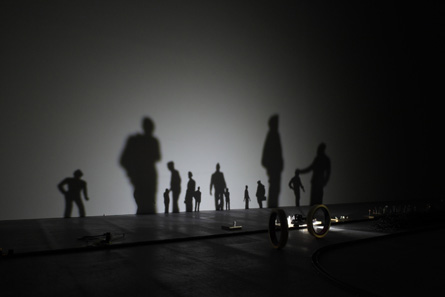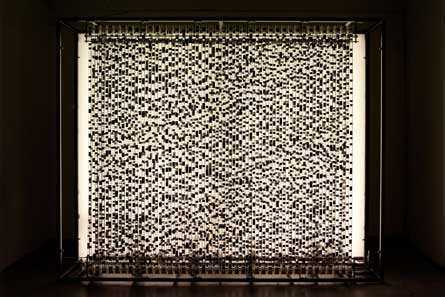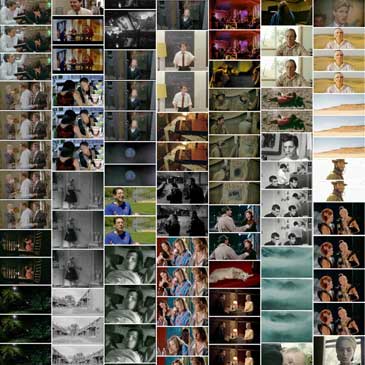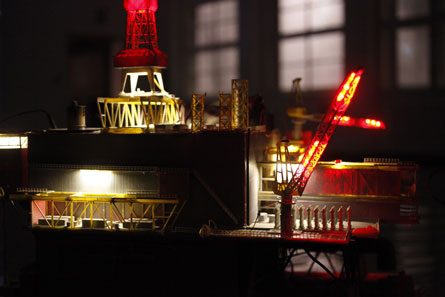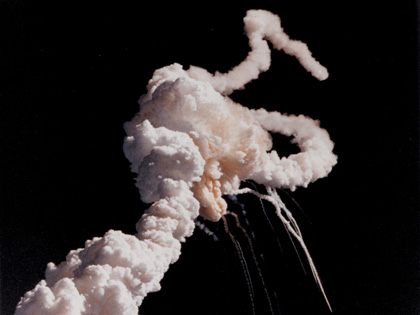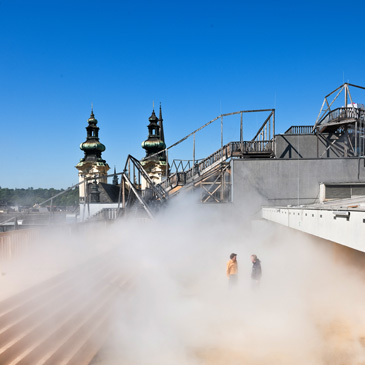THE ARS ELECTRONICA FESTIVAL IN LINZ
by Dominique Moulon [ October 2011 ]
The oldest of digital festivals has returned to its preferred sites at the Ars Electronica Center, the Brucknerhaus, the Lentos and OK Centrum (where another exhibition was being held, the Hohenrausch) after a very brief turn at the Tabakfabrik. Meanwhile, the symposium for this 2011 edition, entitled Origin, was organised in collaboration with the CERN.

Pre cinema
Ryota Kuwakubo,
"Lost #2", 2010,
Source Keizo Kioku,
Courtesy ICC.
 T
There is a piece that is so quiet and fragile placed high up at the
Ars Electronica Center, protected from the rest of the exhibition by the obscurity of its own environment that one might easily miss it. "Lost #2" pays homage to pre cinema in a museum dedicated to the most innovative technologies! It is easy to image the artist
Ryota Kuwakubo meticulously placing everyday objects on a horizontal plane. The lights have been turned off so they cannot be switched on and a small electric train equipped with an electroluminescent diode converts its close surroundings into a fantastic landscape, evolving slowly and smoothly like the image of a 35mm projector. It is like this that he tells us a story of a trip based on the contrasts between shadow and light. Rubber erasers depict a city; crayons, which have definitively lost their colours aligned like standing stones represent a field of obelisks. Farther along in time, a simple colander becomes a light dome, while light-bulbs along the track look like so many water towers. Then suddenly, the reduced model goes back at great speed along its trajectory. The film is then rewound in fast mode. It is an excellent metaphor for evoking the fact that perhaps in the urgency of imminent death, there are stimuli that can trigger the rewind buttons for our entire lives.

Experimental Cinema
Wim Janssen,
"Continuization Loop",
2010,
Source Wim Knapen.
 C
Cinema in the end is an affair of light and until only just recently, it was essentially an affair of film, if and only if you omit the stories, the emotions, the trends and the styles. And the filmmaker, Paul Sharits, who has devoted a part of his life to making films that flicker, would not deny this. The installation "Continuization Loop" by
Wim Janssen, which is presented at the Cyberart exhibition at the OK Centrum, is an interminable loop of 35mm film where there are only black and white images or frames. From top to bottom, as from bottom to top, they scroll before our eyes one column over another while alternatively masking the powerful light that is an integral part of the work. The cinematographic installation, even though resolutely analogical, could easily contain a message encoded in binary language. But who would even want to decode it when we are simply captivated, literally hypnotised by the uninterrupted flow of images of shadows and light. Cinema is also an affair of scale so one steps back to only see noise in the image without being able to turn away.

Special Effects
Rejane Cantoni
& Leonardo Crescenti,
"Tunnel", 2010.
 C
Continuing along at the OK Centrum we ask ourselves whether we are allowed to walk through this sculpture that looks like a corridor at a time when practically every kinetic or minimal piece, even participative, has become untouchable in the museums that house them. But it is indeed in walking through this piece that has been judiciously entitled Tunnel by the Brazilian duo
Cantoni-Crescenti, that it takes on meaning. The ground gradually slips away under our feet while the portal frame corresponding to the sunken slats tilts. The body of the work contorts itself like that of a snake eating its prey. The spectator meanwhile observes this architectural space that literally becomes fluid as they walk through. It is hard not to think of pre-digital special effects when one relied on ingenuity, or of the art of engineers who build tunnels and bridges that combine laws of physics with those of aesthetics. When there are several people in it at once, the experience becomes more complex as the participants also compete with ingenuity to twist this resolutely participative kinetic sculpture in even more imaginative ways.

Cinema sampling
Julian Palacz,
"Algorithmic search for love",
2010.
 T
There are ideas that are trendy. So today, the profusion of existing images encourages certain artists to no longer produce new ones. We speak of cinema sampling or found footage, depending on the contexts. The work, The Clock, by Christian Marclay, has to be linear to be presented in a contemporary art biennale like that of Venice whereas Julian Palacz', "Algorithmic Search for Love", is as interactive as it ought to be for a digital art festival like that of Linz. But there are, in both cases, a vast collection of film sequences mentioning the hour in The Clock and words in Algorithmic Search for Love. Where time predominates in the first, it is words that are entered by spectators in the second piece that are taken into account by the machine that is carrying out the editing it is broadcasting in real time. It is thus samples of I love you, or holy shit that follow one after the other in the image from one film to another. Two forms of writing and language are superimposed on one another – that of the Austrian artist who created the algorithm and that of the machine carrying out the orders of the public.

Biology in Art
Art Orienté Objet,
"May the Horse Live in Me",
2011, Source Miha Fras.
 A
Ars Electronica is among the digital art festivals incorporating artistic practices that question the living. It is in fact one of the reasons for the Golden Nica award for Hybrid Art that was this year awarded to members of the French collective,
Art Orienté Objet. Their project, May the Horse Live in Me, began a few years ago. Since then, Marion Laval-Jeantet has gradually been preparing to receive the dose of horse immunoglobulins that Benoit Mangin injected into her at the Kapelica Gallery of Ljubljana, in Slovenia, during the performance of February 22, 2011. We see Marion putting on prostheses so that she can be at eye level with the horse in the video that documents this fusion that goes beyond the symbolic. She even goes as far as covering the animal's eye with her hand without it really reacting, so trusting it is during the experiment. Later, she confides having detected in herself states she had hitherto not known, well after the momentary rise in her body temperature. But what today might the animal part be that the artist's body has not been able to eliminate? At the end of the performance, the artist puts on the white lab coat again that transforms the human guinea pig she has been into a scientist in a staging that has been meticulously worked out in advance. With Benoit Mangin, she looks at the "half blood" he has just sampled from her. The blood of a Centaur!

In miniature
HeHe,
"Is there a horizon
in the deep water?",
2011.
 T
There are coloured lines on the floor of the OK Centrum. Following them, they indicate the cohabitation of artists from two distinct exhibitions within the same space. This is the case in the main room that Stefan Banz has flooded to convert into an inland sea, while the
HeHe Collective have placed a scale model of an oil rig there. The title of this second installation, Is there a horizon in the deep water? reminds us of the recent catastrophe that polluted the waters of the Gulf of Mexico. It is precisely this sad event that Helen Evans and Heiko Hansen reconstruct with the help of fireworks and smoke when night falls. We are used to the idea of reconstructing things and every battle, even the most bloody, has been replayed again and again. One can easily obtain a miniature Napoleonic soldier or a combat airplane, whereas scale models of oil-rigs and nuclear reactors are reserved for the Hollywood film industry. Is the general public better prepared for the reconstruction of human rather than industrial catastrophes? Is there indeed a kind of urgency to forget the errors that we can consequently repeat more easily?

Theory of catastrophe
Ralo Mayer,
"Obviously a Major
Malfunction", 2011,
source Kennedy
Space Center,
NASA, 1986.
 E
Even more catastrophes are evoked in the basement of the
Lentos occupied by Ralo Mayer. The Austrian artist invites us to resolve the enigmas of fragments coming, one from deep space in the form of a meteorite that is more than 4 billion years old, and the other from the Chernobyl nuclear reactor. Then there is this "magnificent" plume of white smoke caused by the explosion of the Challenger Space Shuttle, without actually reconstituting that of the Columbia on the ground. "Obviously, a major malfunction" caused these two space catastrophes. Perhaps there were also a few human errors, even minute and therefore comparable to the beating of a butterfly's wings, which followed after one another during the assembly of what Ralo Mayer qualifies as the "the most complex piece of machinery of all times". Unless we believe, like Paul Virilio, in the inherent potential for catastrophes in inventions themselves because, "Inventing the ship implies inventing the shipwreck, the plane, the crash and the train the derailment".

Up above Linz
Fujiko Nakaya,
"Cloud Parking in Linz", 2011,
Source Otto Saxinger.
 T
The other exhibition at the
OK Centrum is entitled Hohenrausch and extends above the rooftops of buildings that can be observed from suspended wooden bridges built by the Bow-Wow workshop. Wandering about like this high above the city, we feel kind of close to the clouds and our bodies disappear when engulfed by those created artificially by Fujiko Nakaya. But only the cause is artificial because it is just water vapour from atomisers being dispersed around the spectators. The Japanese artist has thus been sculpting clouds whose only artifice is the mechanism that creates them since her world premier in 1970 at the universal exhibition of Osaka. But what a pleasure it is to disappear here, to reappear there, and to play with this artificial nature. What an intense pleasure it is becoming hypersensitive to every little sound as soon as we find ourselves temporarily in a fog. And one's head becomes lighter by the body's disappearance while the hands ceaselessly reach out to scrutinize the invisible and the unknown. Half submerged, it is the visible part of the world that we observe, just like the Wanderer Above the Sea of Fog by Caspar David Friedrich.

Written by Dominique Moulon for Digitalarti and translated by Geoffrey Finch, October 2011.
